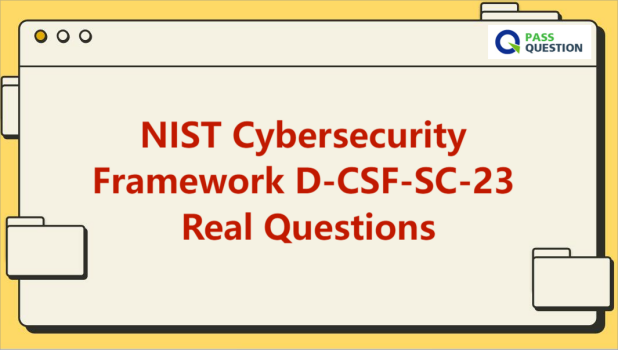NIST Cybersecurity Framework D-CSF-SC-23 Real Questions
To ensure your success in the first attempt of the D-CSF-SC-23 NIST Cybersecurity Framework 2023 Exam, we highly recommend utilizing the latest NIST Cybersecurity Framework D-CSF-SC-23 Real Questions from PassQuestion. These comprehensive and up-to-date questions are specifically designed to help you pass the exam with flying colors. By utilizing NIST Cybersecurity Framework D-CSF-SC-23 Real Questions, you will have access to all the necessary exam content, allowing you to fully grasp and master all the objectives. With the help of these NIST Cybersecurity Framework D-CSF-SC-23 Real Questions, passing your exam will be made much easier and more achievable.

D-CSF-SC-23 Exam Overview - NIST Cybersecurity Framework Exam
The examination covers both broad framework topics and specific underlying processes that support the implementation of the framework. This includes the central elements of the framework, as well as its tiers and profiles, which enable CSIRT staff to assess risk and prioritize changes to features based on business requirements and shifts in the security landscape. The Dell EMC NIST Cybersecurity Framework certification is primarily intended for individuals who wish to pursue a career in Infrastructure Security. Successful completion of the Dell EMC NIST Cybersecurity Framework exam demonstrates that the candidate possesses essential knowledge and demonstrated skills in the field of Dell EMC DCS.
DELL D-CSF-SC-23 Exam Details
Exam Name: Dell NIST Cybersecurity Framework
Exam Code: D-CSF-SC-23
Exam Price: $230 (USD)
Duration: 90 mins
Number of Questions: 60
Passing Score: 63%
NIST Cybersecurity Framework D-CSF-SC-23 Exam Objectives
NIST Framework Overview (10%)
● Describe the NIST Framework architecture and purpose including the Core, Tiers, and Profiles
● Describe the topics associated with the Category layer and explain how they align to the NIST Framework functions
NIST Framework: Identify Function (18%)
● Describe what constitutes an asset and which assets need to be protected
● Describe the "who/what/why" of a continuously updated inventory
● Describe how discovery and inventory facilitates the planning efforts associated with Disaster Recovery, Incident Response, Communications, and Business Impact Analysis
● Describe the controls for the inventory classification and explain the KPIs developed around these controls
NIST Framework: Protect Function (23%)
● Describe the need for creating and documenting a baseline configuration
● Explain how the Business Impact Analysis is integral to the protect function
● Describe the role of the Business Continuity Plan and Business Impact Analysis
● Describe the maintenance and access control subcategory controls for the protect function
● Describe the awareness training, data security and protective technology subcategory controls of the protect function
NIST Framework: Detect Function (17%)
● Describe the anatomy of a breach, including what constitutes a breach, why and how it happens, and the steps to avoid a breach
● Identify the methods of detection and how detection can be implemented
● Describe the concept and benefits of continuous monitoring
● Identify and explain the subcategories associated with detection and analysis
NIST Framework: Respond Function (17%)
● Describe how to quantify the extent of a security breach
● Describe how to contain a security breach
● Understand and construct an effective Incident Response Plan
● Describe the purpose and details of an effective Communications Plan
● Describe the after action plan and review
NIST Framework: Recover Function (15%)
● Determine and describe the considerations when implementing a Disaster Recovery Plan (DRP)
● Describe how the BCP (Business Continuity Plan) supports “timely recovery to normal operations to reduce the impact from a cybersecurity incident.”
● Assess and describe the requirements and processes to return to "business as usual"
● Describe the process of understanding the impact to the business, including reputation and revenue
View Online NIST Cybersecurity Framework D-CSF-SC-23 Free Questions
1. Consider the following situation:
- A complete service outage has occurred, affecting critical services
- Users are unable to perform their tasks
- Customers are unable to conduct business
- Financial impact is beyond the highest allowed threshold
What is the correct classification level for this situation?
A. Safety critical
B. Mission critical
C. Business critical
D. High impact
Answer: B
2. What activity is supported by the Protect function in the NIST Cybersecurity Framework Core?
A. Take action regarding a detected cybersecurity event
B. Manage cybersecurity risk to systems, assets, and data
C. Ensure delivery of critical infrastructure services
D. Ensure resilience and restore services impacted by a cybersecurity event
Answer: C
3. What is the purpose of the Asset Management category?
A. Prevent unauthorized access, damage, and interference to business premises and information
B. Support asset management strategy and information infrastructure security policies
C. Avoid breaches of any criminal or civil law, statutory, regulatory, or contractual obligations
D. Inventory physical devices and systems, software platform and applications, and communication flows
Answer: D
4. What is used to identify critical systems, networks, and data based on their criticality to business operations?
A. Business Impact Analysis
B. Business Organization Analysis
C. Incident Response Plan
D. Business Continuity Plan
Answer: A
5. What is used to ensure an organization understands the security risk to operations, assets, and individuals?
A. Risk Management Strategy
B. Risk Assessment
C. Operational Assessment
D. Risk Profile
Answer: B
- TOP 50 Exam Questions
-
Exam
All copyrights reserved 2025 PassQuestion NETWORK CO.,LIMITED. All Rights Reserved.

